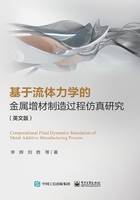
2.1 Introduction
As an emerging technology,AM has great potential for application in several fields,such as aerospace,the automotive industry,biomaterials,and healthcare [1].AM,also known as 3D printing,is the process of joining materials to create objects from 3D models,usually layer-by-layer [2] offers significant advantages (the ability to create intricate geometries,the elimination of specialized tooling,and reduction in material wastage) over the traditional subtractive and formative manufacturing processes [3]. With rapid development in AM technologies,a more extensive range of objects with complex geometries can now be fabricated effectively [4].
Laser-based Powder Bed Fusion (L-PBF) is an AM technology that enables the production of lightweight structural components having a series of identical mechanical properties,without the need for part-specific tooling or downstream sintering processes [5]. Compared with conventional machining,a major drawback of the L-PBF process is limited surface quality. Furthermore,limited residual porosity (1%~2%) of parts fabricated using L-PBF technology may be problematic when high strength and fatigue resistance are necessary [6]. To alleviate this problem,inert gases can be pumped into an L-PBF printer during printing. Further,the gas flow in the printer is used to remove by-products such as spatters and welding fumes [7]. In addition to the shielding properties of inert gases,shielding gas flow is a crucial factor affecting process stability and part quality [8].Insufficient removal of by-products or inhomogeneous distribution of the flow field may result in interaction between the laser and the by-products [9],leading to attenuation of the laser spot and redeposition of the by-products on surfaces that are subsequently exposed to the laser [8].
Many experts have investigated the flow field of shielding gas and spatter particles. Wang et al. [7] improved the uniformity of the shielding gas flow. They found that a high gas flow velocity and large nozzle-to-plane distances resulted in relatively better uniformity in gas flow. Ferrar et al. [9] simulated the relationship between shielding gas and printing quality. The results showed that the improved gas flow significantly impacted the value and standard deviation of the measured properties,reduced porosity by 1.7%,and improved the standard deviation of compressive strength from 12 to 5 MPa. Kong et al. [10] linked gas flow uniformity on an MTT Realizer L-PBF 250 to quality. They suggested that changing the gas guidance system could improve part quality. The results of the study showed an unevenly distributed gas flow. In particular,decreased gas flow velocity was observed near the gas outlet. The authors [10] emphasize the influence of gas flow on the density and surface morphology of the fabricated parts. Ly et al. [11] conducted an experimental study on the characteristics of molten pools and spatters. They used high-speed imaging and other high-speed optical diagnostics to explore the dynamics of the ejection pool and the motion of the ejection section. Aeschliman et al. [12] used high-speed imaging to capture the dynamics of the ablation process,which revealed that particle motion during ablation exhibited a molten pool geometry-a complex interaction between metal vapor flow and ambient gas pressure. Matthews et al. [13] studied the formation of spattered powder during laser scanning in the L-PBF printer chamber by varying the inert gas flow rate and the single-pass scanning direction. They quantified and analyzed the splash powder that accumulated at the bottom left of the building chamber and found that surrounding gas flow resulted in the accumulation of more particles on the left side.
This study systematically and comprehensively investigated the flow field,temperature field,and deposition of spatter particles inside the Laser-based Powder Bed Fusion (L-PBF) printer. It constructed a geometric model and a numerical model of a commercial L-PBF printer by verifying grid independence. It also constructed a Gaussian heat source model for the moving laser and a movable particle injection model to study flow characteristics,trajectory,and deposition of spatter particles inside the printer chamber using the commercial computational fluid dynamics software,ANSYS FLUENT 16.0 (ANSYS Inc. Canonsburg,PA,USA),which is based on the finite volume method with user-defined functions (UDFs).